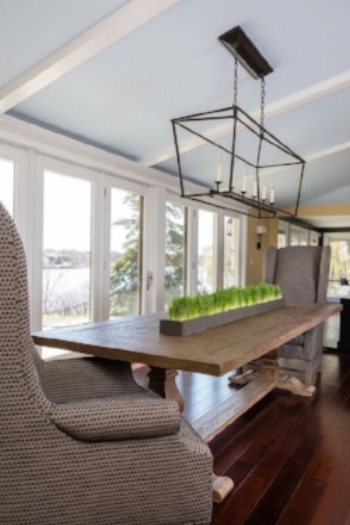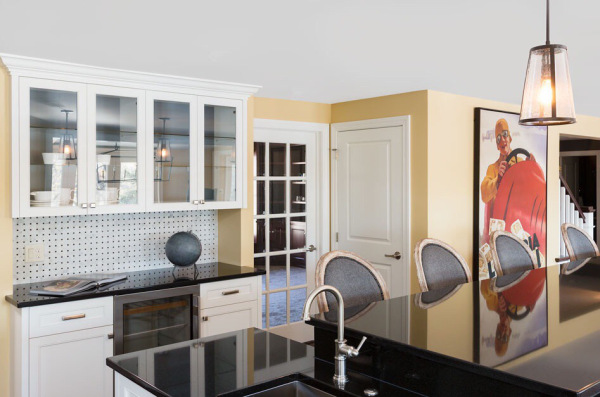A large part of my career has been spent helping clients reach the end of the first design layer in their homes. While quite possibly the most important layer in creating a well designed, fabulous and functional home…it by no means ends there. This first layer is the foundation for every thing that comes after, but it does little to impart coziness, convenience or even the personality of the individual client. The first layer as I define it consists of the layout and finishes. Wall color, flooring, cabinet, lighting, plumbing, and counter top selections…the “finish bones” of the house that combined with a well thought out and client tailored floor plan create that all important first layer. But at this point, the home is still a shell awaiting the customization that the next layers impart. For most people building a new home or doing a large scale remodeling project, it is impossible to do anything besides focus on this first layer until it's completed. Many times I've asked questions about furnishings or window treatments while selecting interior finishes with a client and they’ve responded that they’ve given no thought to those items and warned me that their head may spin off and blow up if I insist we discuss it then and there. But the reality is, if we fail to visualize and consider our design Gestalt, we jeopardize the unity of the space and are much more likely to make missed steps along the way that will prevent us from truly making our house the home we desire and need.
In order to achieve that aesthetic cohesiveness and the seamless function we aspire to, visualization and creation of a design thought hierarchy are both essential. In other words, if you fail to plan, you plan to fail. This is where your professionals come into the picture. The architect and/or general contractor lay the groundwork quite literally for the home. With the client leading the way, they establish the floor plan, site plan, construction schedule and overall create a concept of the homes existence taking it from a dream into the first step toward reality. This is an exciting step, with the right pros on board clients begin to understand options and the ability to customize the home. It can also be overwhelming to certain home owners for the exact same reasons. Enter the professional interior designer.
The interior designer client relationship can possibly be even more personal than the one the client has with the GC and architect. The designer should learn about the clients personality and lifestyle to a more detailed degree so they can fully understand the client needs and wants. And since the designer often speaks on behalf of the client throughout the process of building or remodeling, it is essential that the client and designer have good communication and a great working relationship. It certainly helps if the client and designer create a friendship and enjoy each other's company as much time will be spent together sharing thoughts and they may potentially encounter opposing views while making decisions together. The designer should help the home owner keep their thoughts organized and focused while at the same time never losing track of the overall design goals typically established at the first couple client meetings. A good designer is the keeper of the design Gestalt allowing the client to keep their sanity and live life as close to “usual” while going though the consuming process of designing and building their dream home. A good designer should offer new ideas and product options to the client appropriate to the big picture while always respecting the clients own personal tastes and wishes. With this directed focus, the first layer of design can easily and beautifully be completed making the experience enjoyable for the client.
The next layer includes major furnishings, appliances, window treatments and closet storage solutions. If the overall design goals have been considered throughout the process, all the appliances and furnishings will not only fit the spaces they serve but they will also be aesthetically and functionally ideal in their role. Window treatments are often times neglected in the early stages of design planning. A poorly thought out piece of door hardware, the wrong patio door or window selection can substantially narrow window treatment options taking the overall design to a place the client never intended or wanted. Closet storage solutions should be discussed early in the design process also to ensure the clients storage needs can be met with the planned storage space. The general contractor can make modifications to storage areas as long as it happens early enough in the planning and construction process. The devil is truly in the details, and having an interior design pro involved early on whom you can draw from their experiences is key to ensuring you will not make mistakes along the way, or if you do…that you receive guidance to reasonable and workable solutions.
Next comes the all important fluffy part of designing your home…the final design layer. This is the opportunity to add color, texture and interest with artwork, rugs, accessories and secondary furnishing items. This is accomplished by incorporating personal items that not only look great in the spaces but evoke memories of the clients family, friends, travels and life experiences. Whether they were previous possessions, family heirlooms, flee market finds or newly purchased items…these elements add true personality and customize the spaces. If this last layer is well thought out, intentionally these items can be mixed and matched from one room to the next as the designer or the client sees opportunity or reason. They can be changed out over time to help keep the spaces fresh or to make room for more important pieces as they are acquired along life’s path.
Enlist the help of the right professionals for your new construction or remodeling project and it will be the difference between the experience being thoroughly enjoyable or completely miserable and the end result fulfilling your dreams or falling short of justifying the time and monetary investment. Look for professionals who work well together, your contractor may recommend an architect or vice versa. Either your contractor or your architect may suggest a designer to assist you along the way as well. Don’t rush through the process of selecting your own “dream team.” Interview them, ask for references and to see actual homes they have designed or built and photos of past work. Be sure their design style, quality philosophy and business ethics mesh with yours. The process can take years from start to finish and for most families, it will be their one shot at creating a custom home they will literally spend the rest of their life in. Call or email Annette at ABK Interiors to take the first step toward selecting your very own dream team today.











